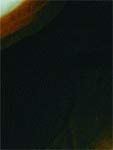'Heeza Sheeza'
Rena's owners weren't exactly sure what they had purchased. They thought that they had bought a mare and she seemed to show some weak cyclical estrous behavior.
Rena's owners weren't exactly sure what they had purchased. They thought that they had bought a mare and she seemed to show some weak cyclical estrous behavior.
Other geldings at the farm seemed to be interested in her during these times and the only stallion around, at a neighboring farm, called to her and paced the fence-line.
The only problem was that this horse wasn't exactly normal. She was a big strong-featured horse at 17.1 hands with a lot of muscle development. She had slightly small mammary glands for her size but with normal teats.
Lifting her tail, however, brought the problem to light, so to speak, because she had a normal rectum but no evidence of a vulva.
On a closer, more detailed examination a vulva was indeed located roughly halfway between the udder and the rectum on the midline. One leg had to be lifted up and away from her body to even see this structure. Her vulva was normal in conformation, slightly small for her size with a larger than normal clitoris.

Rena is a 6-year-old, 17.1 hand draft-cross mare. She is heavily muscled and displays normal mare behavior and mild but present cycles.
Rena's owners still weren't sure. Was she a she, was she a he, or was she something in between?
A he or a she?
Such horses are not common, but they do tend to show up in practice now and then. A knowledge of sexual developmental abnormalities is helpful in determining who's what and in helping clients deal with potential problems generated by these conditions.
The best way to discuss abnormalities in sexual development is to follow a logical sequence of developmental events.
First, there is the genetic sex of the individual. As the genome of a horse becomes more completely mapped we know more about equine genes and their expression.
The genetic sex of an individual is the chromosomal make-up of that individual. This naturally leads into the gonadal sex or the way that the specific gene make-up determines whether a testis or an ovary develops. These gonads then produce fertile gametes, or not, depending on germ cell sex-the capacity of those testis or ovaries to be productive.

Normal mammary glands are present in this mare but note that they can be mistaken visually for a smaller than normal sheath. This horse was thought to be phenotypically a gelding by a number of people who only observed the animal and did not actually examine the mammary area.
Hormonal sex describes the hormones that are produced by the gonads and also incorporates the development of internal genitalia that is under hormonal control. This hormonal control also affects brain sex in that hormone influence on various parts of the developing brain influences other aspects of anatomical development.
We need to next consider phenotypic sex as the process by which differing male and female sex hormones influence the development of secondary sexual characteristics.
Lastly, one can discuss behavioral sex as the way that the individual functions in its herd (society). This discussion in horses is far easier than in humans since we need not worry about social, environmental and other factors that often affect sexual development and determination at many levels.
Obviously sexual development is a very complicated process. And, as with all such complex schemes, things can "go wrong" at any step along the way.
A complicated process
The individuals resulting from abnormalities in this developmental process provide various clinical features and reproductive challenges. Rena's condition is one of many. When a horse displays, either fully or partially, characteristics of both sexes it is called an "intersex". If both testicles and ovaries are present that individual is called a "true hermaphrodite." These individuals are not very common.
More routinely seen are cases where the horse only possesses one gonadal type. These animals are called "pseudo-hermaphrodites" and labeled as either male pseudo-hermaphrodite or female pseudo-hermaphrodite depending on the nature of the gonads, not the outward or phenotypic appearance.
Also present in the population are horses with embryonic abnormalities resulting in normal or near-normal genitalia in an abnormal location. This was originally thought to be a possible explanation for Rena's appearance.

The perineal area of this horse reveals a normal rectum, but no visible vulva.
The normal work-up of a case of sexual abnormality should involve a detailed physical examination, then a rectal palpation and diagnostic ultrasound. These procedures may show internal development of ovaries or testicles. Many times, however, the defects in development have occurred at a very early stage and normal gonads do not develop and are not detected by either palpation or ultrasound.
Normal work-up
This was the case with Rena, and it then ensured that her condition was not merely a normal individual with an embryological "misplacement" of genitalia. While the presence of some type of ovarian tissue was suspected, based on the history of her "cycling", that tissue was not in the form of normal ovaries and nothing was found on ultrasound exam. Blood was drawn and examined for hormonal analysis. Levels of testosterone, estrogen and progesterone were checked.
In this case, Rena's blood assayed as normal for a gelding or a non-pregnant mare. This continues the gender confusion and points out that the sequence of sexual development mentioned above should always be followed in order to determine the "true sex" of an abnormal individual.
Rena appears, phenotypically, to be an abnormal female with some male-like tendencies. She is large, muscular and slightly coarser than a female of her breed. While she has female external genitalia, it is not normal (smaller with enlarged clitoris) and it is abnormally located. She has undetermined hormonal and gonadal sex and it is probably only at the genetic level that we can definitely determine if "heeza sheeza" or not.

This horse's vulva is located midway between the mammary area and the rectum on the midline. To actually view the vulva the right leg was abducted from the body (upper left of photo) and the tip of the stifle can be seen. A small vulva can be seen with a slightly larger clitoris. The left hind leg occupies the lower right portion of the picture.
Equine karyotyping (a determination of the gene structure of an individual) is done only at the Molecular Cytogenetics Laboratory in the Department of Veterinary Anatomy and Public Health at Texas A&M University in College Station, Texas. The testing requires 10 ml of blood collected in sodium heparin (vacutainer) tubes. Dr. Bhanu Chowdhary who runs the equine karyotyping services at Texas A&M and who authored the chapter on Cytogenetics and Physical Gene Maps in The Genetics of the Horse (CABI Publishing, eds. A.T. Bowling and A. Ruvinsky), cautions practitioners to wrap the tubes in paper towels before packing in ice as the blood should not be frozen. The samples should then be sent overnight. Equine karyotyping costs $150 per sample.
Karyotyping
Chowdhary reports that roughly 50 cases have been tested for suspected hermaphrodism and of these only 11 had abnormal genetic make-up. "A wide range of numerical aberrations of the sex chromosomes are known in the horse," he writes, "and the karyotype XO is among the most common-57 percent- of all sex chromosome abnormalities."
This condition is called Turner's syndrome in humans and the effects are similar in both species. Affected individuals are shorter than normal with poor body conformation, small gonads lacking follicular development and an irregular or absent estrus cycle. These individuals are usually infertile though an occasional pregnancy may occur. This is especially true in horses if these mares are bred early in life.
Another abnormality, XXX is also present in horses, though it is rare-only 11 cases reported to date. Chowdhary feels that there may be more of these mares however but, since genetic evaluation is usually not done, they go undetected.
XXX mares are phenotypically normal but uniformly infertile. Another condition causing problems in the horse is X/XX. This mosaic condition represents 20 percent of all sex abnormalities in the horse. These mares are again phenotypically normal with normal external genitalia but with "gonadal dysgenisis."
These mares vary from subfertile to sterile, according to Chowdhary.
An Arabian mare with a history of fertility problems was later diagnosed as XX/XXX with gonadal dysgenisis. It may be that a higher than previously thought percentage of particularly difficult breeding cases may, in fact, be genetically abnormal mares that remain barren despite the best veterinary and management efforts. More attention should probably be focused on karyotype analysis of potential problem breeders.
Sex reversal is a condition where there is a disagreement between the karyotypic sex and the phenotypic sex. Chowdhary reports that more than 120 such cases have been reported in the horse. XY individuals are expected to be males, but in sex reversal they appear more like females. This is the second most common abnormality in infertile mares.
Sex reversal
XX sex reversal is far less common but does occur. Individuals with these conditions appear mostly as female with varying degrees of external male-like sex characteristics. The external genitalia may be normal, but there may be intra-abdominal testis, ovaries or both.
These abnormalities are of interest in that they may explain some clinical or behavioral problems that have occurred in horses.
It is apparent that more karyotyping should be done and that this may then give us a clearer picture of these special individuals and their true percentages in the general population.
In reality though, once the genetics of a horse have been determined, there is little that can be done clinically as far as management goes.
"One can try hormonal therapy with these horses," says Chowdhary, "but they are unlikely to show much response."
Some clients are also unwilling to challenge their perception of their horse's gender.
Clients' perceptions
This tends to occur more often with horses kept as companions but it is surprising in some professionals and broodmare owners as well.
Rena's owners were convinced that "she" was a mare and had been relating to her as such. Even with all the information that was uncovered during the physical exam, ultrasound and hormonal analysis, they decided that she was a she. Since breeding was not an issue, they did not wish to pursue the diagnosis any further.
Dr. Marcella, a 1983 graduate of Cornell University's veterinary college, was a professor of comparative medicine at the University of Virginia. His interests include muscle problems in sport horses, rehabilitation and other performance issues.